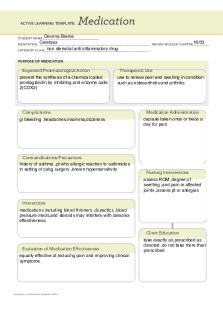Medication Template Isophane Insulin NPH (Humulin N, Novolin N) PDF

| Title | Medication Template Isophane Insulin NPH (Humulin N, Novolin N) |
|---|---|
| Course | NR 324 ADULT HEALTH |
| Institution | Chamberlain University |
| Pages | 1 |
| File Size | 64 KB |
| File Type | |
| Total Downloads | 84 |
| Total Views | 134 |
Summary
Download Medication Template Isophane Insulin NPH (Humulin N, Novolin N) PDF
Description
ACTIVE LEARNING TEMPLATE:
Medication
STUDENT NAME _____________________________________
Isophane Insulin NPH (Humulin N, Novolin N) MEDICATION __________________________________________________________________________ REVIEW MODULE CHAPTER ___________ Pharm ch.39
pancreatics(Pharm)/antidiabetics(Therapeutic) CATEGORY CLASS ______________________________________________________________________ PURPOSE OF MEDICATION
Expected Pharmacological Action ● Promotes cellular uptake of glucose (decreases glucose levels) ● Converts glucose into glycogen and promotes energy storage ● Moves potassium into cells (along with glucose)
Therapeutic Use Control of hyperglycemia in diabetic patients.
Complications ● Hypoglycemia ● Hypokalemia ● Lipohypertrophy
Contraindications/Precautions Contraindication: hypoglycemia; allergy or hypersensitivity to a particular type of insulin, preservatives, or other additives. Caution: stress and infection(may temporarily increased insulin requirements); renal/hepatic impariment(may decreased insulin requirements); Concomitant use with pioglitazone or rosiglitazone (increased risk of fluid retention and worsening HF; OB: pregnancy may temporarily increased insulin requirements.
Interactions ● Sulfonylureas, meglitinides, beta blockers, and alcohol have additive hypoglycemic effects with concurrent use. ● Concurrent use of thiazide diuretics and glucocorticoids can raise blood glucose levels and thereby counteract the effects of insulin. ● Beta blockers can mask SNS response to hypoglycemia(tachycardia, tremors), making it difficult for clients to identify hypoglycemia. Beta blockers also impair the body's natural ability to breakdown glycogen stores to raise blood glucose levels.
Evaluation of Medication Effectiveness Control of blood glucose levels in diabetic patients without the appearance of hypoglycemic or hyperglycemic episodes.
ACTIVE LEARNING TEMPLATES
Medication Administration Dose depends on blood glucose, response, and many other factors. Subcut ● 0.5~1unit total insulin/kg/day. ● Assess patient for signs and symptoms of hypoglycemia and hyperglycemia periodically during therapy ● Monitor body weight periodically. changes in weight may necessitate changes in insulin dose. ● LAB: blood glucose Q6hr, Hemoglobin A1c every 3~6 month to determine effctiveness, potassium ● Toxicity and overdose: overdose - hypoglycemia
Nursing Interventions ● Check insulin type, dose, and expiration date, unit with anothe nurse. ● Use only insulin syringes to draw up dose. ● When mixing insulins, draw regular insulin first to avoid contamination of regular insulin vial. ● Stored in a cool place but do not need to be refrigerated. Once opened, store at room temperature. ● When transferring from once-daily NPH human insulin to insu glarfine, the dose usually remains unchanged, When transferrin from twice-daily NPH human insulin to insulin glargine, the initia dose of insulin glargine is usually reduced by 20%. ● NPH insulin should not be used in the management of ketoacidosis. ● SubcutL administer NPH insulin within 30~60min before a meal.
Client Education • Proper use of syringes and vials is important, as is the proper storage of the insulin. • Testing of serum glucose and ketones is important, especially for sick day care. • Carry a glucose source and wear a Medic-Alert bracelet. • Carbohydrate counting is a useful method for diet planning to control blood glucose. • Know signs of hypoglycemia and hyperglycemia and actions to take. • Notify health care professional if pregnancy is planned or suspected....
Similar Free PDFs

Drug Card - NPH Insulin
- 2 Pages

Fast Acting Insulin Medication
- 1 Pages

Tuyết Hân - nk,n,n,
- 123 Pages

ATI Warfarin Medication Template
- 1 Pages
Popular Institutions
- Tinajero National High School - Annex
- Politeknik Caltex Riau
- Yokohama City University
- SGT University
- University of Al-Qadisiyah
- Divine Word College of Vigan
- Techniek College Rotterdam
- Universidade de Santiago
- Universiti Teknologi MARA Cawangan Johor Kampus Pasir Gudang
- Poltekkes Kemenkes Yogyakarta
- Baguio City National High School
- Colegio san marcos
- preparatoria uno
- Centro de Bachillerato Tecnológico Industrial y de Servicios No. 107
- Dalian Maritime University
- Quang Trung Secondary School
- Colegio Tecnológico en Informática
- Corporación Regional de Educación Superior
- Grupo CEDVA
- Dar Al Uloom University
- Centro de Estudios Preuniversitarios de la Universidad Nacional de Ingeniería
- 上智大学
- Aakash International School, Nuna Majara
- San Felipe Neri Catholic School
- Kang Chiao International School - New Taipei City
- Misamis Occidental National High School
- Institución Educativa Escuela Normal Juan Ladrilleros
- Kolehiyo ng Pantukan
- Batanes State College
- Instituto Continental
- Sekolah Menengah Kejuruan Kesehatan Kaltara (Tarakan)
- Colegio de La Inmaculada Concepcion - Cebu











